

Latest. 's 30th Anniversary. When EFF was founded on July 10, 1990, it was revolutionary to imagine ordinary people possessing technology that could instantly erase distance, create connection, and access much of the world’s knowledge.

The early Internet was an extraordinary place burgeoning with possibilities, and while the early users of digital world didn’t necessarily reflect the wider world or always get things right, they could see that this “new home of Mind” would change everything. But EFF wasn’t founded on a naïve belief that the coming change would create a digital utopia. Quite the contrary. For all the joy, creativity, and togetherness that technology can help bring, EFF took root because even from those early days it was clear that powerful new digital tools could be used to hurt as well as to heal.
Censorship, corporate and government surveillance, and efforts to lock down and control innovation and innovators were all present from the beginning, too. Cindy CohnEFF Executive Director. Virtual & Augmented Reality Field Trips. Explore the World Without Leaving the Classroom If you haven’t dipped your toes into the world of virtual reality (VR) or augmented reality (AR) yet, you and your students are missing out!
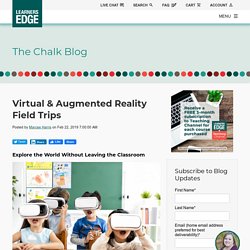
You may be thinking, what is this VR/AR buzz all about and how do I fit it into my already busy day? The Use of AR and VR to Change the Future of Music - Wharton Neuroscience Initiative. Written by WiNSS Scholars Matt DeCesare & Homer Wang Music is an experience.

Consumers and makers of music now demand more and more immersive and interactive experiences, which has prompted an urgent call for innovative designs, models, and technologies. These innovations can take on many forms, including online programs, offline services, and physical products, but in this article, we aim to explore only those of the mobile digital features that existing or future mobile applications could consider implementing based on technology like Augmented Reality (AR) and Virtual Reality (VR). 10 Revolutionary Augmented Reality Apps That You Should Know About. Everyone in the tech industry has probably already heard of augmented reality, from the far and futuristic concept it smoothly broke through the achievable technology.

A study conducted by The Boston Consulting Group shows that more than 80 million people engage with AR on a monthly basis, and this is just in the US. A couple of years from now, AR has a lot of surprises and unconventional ideas for augmenting the real world. Now, in 2019, AR continues to grow rapidly, as more and more companies and startups look to develop their own sophisticated technologies. Whether you are an Android or iOS user, the choice of augmented reality apps is wide. Virtual & Augmented Reality Field Trips. The 10 Best AR Apps for Classrooms Using Apple’s New ARKit. The recent popularity of augmented reality (AR) and virtual reality (VR) has put a spotlight on immersive technology—and our curriculum may never look the same again.
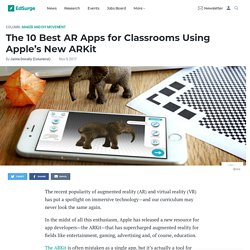
In the midst of all this enthusiasm, Apple has released a new resource for app developers—the ARKit—that has supercharged augmented reality for fields like entertainment, gaming, advertising and, of course, education. The ARKit is often mistaken as a single app, but it’s actually a tool for developers to create their own apps. Already, it has opened up the AR floodgates for newer Apple devices, and developers have been showcasing their new apps on social media using the hashtag #ARKit. The latest apps include technology that simulate realistic experiences, making AR more useful than ever in our daily lives. 5 Ways To Use Augmented Reality In the Classroom. Augmented Reality has gone from something of the future to a unique and interactive way to engage classrooms like never before.
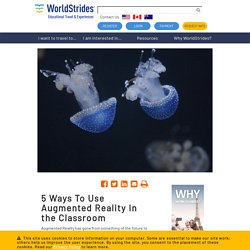
First, what is Augmented Reality? It is a “technology that layers computer-generated enhancements atop an existing reality in order to make it more meaningful through the ability to interact with it.” AR is developed into apps and used on mobile devices to blend the digital and real worlds in a way that enhances each another, but can also be told apart easily. (Source). AR is quickly becoming mainstream. Here are a five ways to use augmented reality in the classroom.
Aurasma – Already one of the most apps for teachers to bring AR into the classroom, the Aurasma app allows teachers to create their own “Auras” or AR experiences. THE BENEFITS OF AUGMENTED REALITY IN EDUCATION – QuantumERA. Incorporating immersive technologies like augmented reality (AR), virtual reality (VR) and mixed reality (MR) into education has been shown to improve learning efficiency and is more effective at teaching students than compared to other media such as books, videos, or desktop computer experiences.
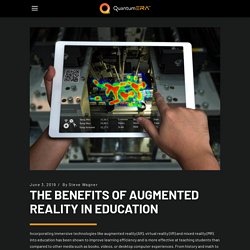
From history and math to chemistry to biology, with some creativity AR can be incorporated into practically any subject. Capturing that “wow factor” is probably one of the most common reasons educators include AR and VR in their lessons. Benefits include: 6 Benefits and 5 Examples of Augmented Reality in Education. Augmented reality in education is surging in popularity in schools worldwide.

Through augmented reality (AR), educators are able to improve learning outcomes through increased engagement and interactivity. Education Solutions. Local Training Finder. Latest. Mental Health. Brain-Based Learning. Online Learning. 4 Tips for Teachers Shifting to Teaching Online. The coronavirus has caused widespread school closures for an unknown duration.
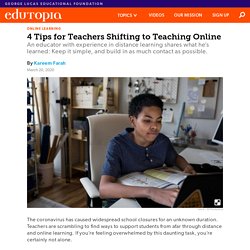
Teachers are scrambling to find ways to support students from afar through distance and online learning. If you’re feeling overwhelmed by this daunting task, you’re certainly not alone. I’ve also struggled to reach students outside of class. For several years, I taught in communities where students struggled to attend school consistently. To help absent students access my courses, I developed a blended, self-paced, mastery-based instructional model that empowered all my students to learn, whether they were in my room or not. Edutopia. 5 K-12 trends to watch in 2020. The past year saw continued investment by states and districts in the additional decision-making freedom allowed under the Every Student Succeeds Act, particularly when it comes to requirements on providing a "well-rounded" education, as well as ongoing concern over efforts to harden school security.
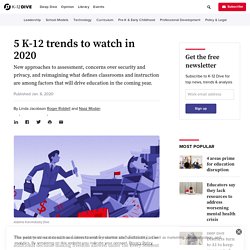
In many districts nationwide, stagnant pay and benefits, alongside a range of school and classroom conditions, saw an even greater number of educators hit the picket lines. These efforts and others stand to play a key role in driving the education conversation in the new year. Edtech Trends To Watch In 2020. In 2019, the U.S. edtech industry was worth about a billion dollars.
But valuations of expressly educational technology paint an incomplete picture of the relationship between technology and education. Really, almost any gadget or piece of software can play a key role in the classroom. It all depends on how it’s used. TikTok isn’t edtech, per se, but high schools have TikTok clubs. 3D printers can build homes and experimental space habitats, but they can also print out educational fossil replicas. Even VR headsets, staples of gaming, open up a world of possibilities in the classroom — though for a long time, a classroom set of them was impractical. 6 Ed Tech Trends to Watch in 2020. Virtual Roundtable Page 4 of 4 6 Ed Tech Trends to Watch in 2020 Burns: In 2020, it'll no longer be a question of whether an institution is considering the use of predictive analytics to inform advising. Instead, questions will be about how data is being leveraged to transform your campus culture for the better. The Top 5 Tech Trends That Will Disrupt Education In 2020 - The EdTech Innovations Everyone Should Watch.
One solid indicator that EdTech is big business is the number of billionaires the sector created. According to Deloitte, the Chinese education market should reach $715 billion by 2025 and was responsible for creating seven new billionaires. The richest was Li Yongxin, who leads Offcn Education Technology that provides online and offline training for individuals who want to take civil service exams, but there were other EdTech business leaders represented. Here we consider the key technologies that underpin the EdTech revolution as well as the top 5 tech trends set to disrupt education in 2020. Key Technologies that Underpin the EdTech Revolution A discussion about the top tech trends that will disrupt education must first begin with the technologies that will influence these trends.
Five Top Technology Trends in Special Education. Fueled by technological advances, changing state policies, and a continued push from advocates, ed-tech companies and researchers are crafting new tools and strategies to better serve students with disabilities. Underlying a range of new trends, experts say, is a growing recognition that designing learning resources from the beginning with students with disabilities in mind can benefit all students. “Developers and [K-12] consumers are now very tuned in,” said Cynthia Curry, the director of the National Center on Accessible Educational Materials for Learning, more commonly known as the AEM Center. Top 24 Educational Trends for 2020 [Updated]
Every year we are seeing a change of trends in almost all sectors and the case is no different in the field of education. This is one of the areas we see a lot of remarkable changes every year. It makes serious impacts on a student’s perspective on education and the learning outcomes. It depends on a lot of factors including available resources, what options are affordable for a larger society and the changing needs or demands of the present generation students. Education trends are dynamic in nature. The top five educational trends to look out for in 2021. Upcoming Educational Trends That Will Change The Future of Children's Educational System. 6 Ed Tech Trends to Watch in 2020. Virtual Roundtable.
Top 6 Trends That Will Shape Future Of Education In 2020. Vishal Bhojane December 30, 2019. Emerging Technologies. The Common Core and Digital Skills Development. The Common Core State Standards (CCSS) is a powerful set of expectations for student learning that has been adopted by districts across the country. One of the phrases associated with this document is college and career readiness. Best Websites for Virtual Teaching! 5 Habits That Allow Me to Work ONLY Contract Hours as a Teacher. Section 5 Online Professional Learning Quality Checklist FINAL. Section 5 Online Professional Learning Quality Checklist FINAL. How Music Class Participation Can Spark Brain Development. EVANSTON, Ill. – Music training has well-known benefits for the developing brain, especially for at-risk children. Why is Music Education in Schools Important? - The Inspired Classroom.
13 of the Latest Trends in Educational Technology. Gardner's Theory of Multiple Intelligences. When you hear the word intelligence, the concept of IQ testing may immediately come to mind. Intelligence is often defined as our intellectual potential; something we are born with, something that can be measured, and a capacity that is difficult to change. In recent years, however, other views of intelligence have emerged. Trends in Educational Technology for 2020. What are the biggest educational technology trends we’ll see heading into the next decade? Educational Technology Trends In 2020-2021. The Key To Gen Z Is Video Content. How To Engage Generation Z In The Virtual Classroom.